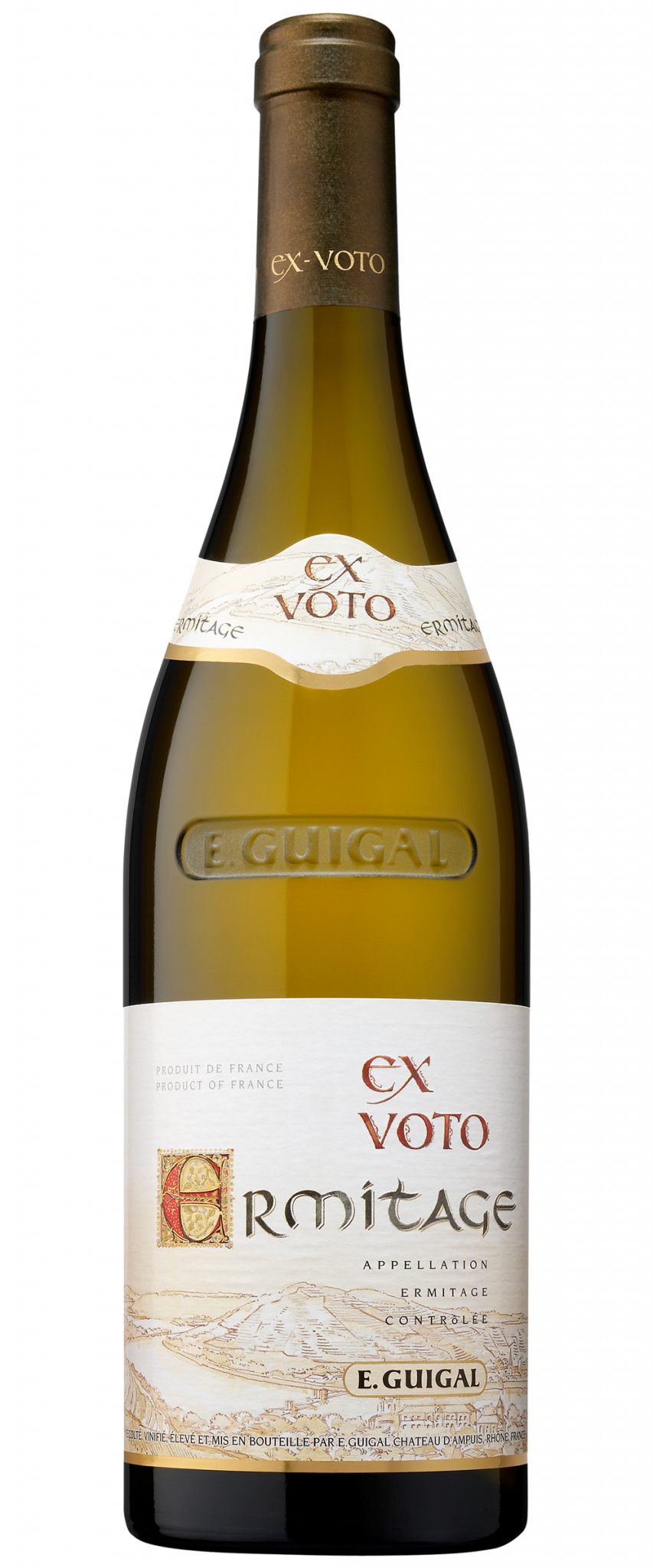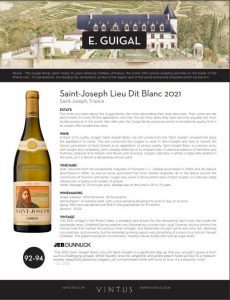
E. Guigal
Saint-Joseph Lieu Dit Blanc 2021
Saint-Joseph
Guigal’s Saint-Joseph Lieu Dit Blanc comes from the vineyard that gives the Saint-Joseph appellation its name, and is one of the finest sites in the Northern Rhone Valley. Made in minuscule quantities, the Lieu Dit Blanc is one of the most original and distinctive whites in the Rhone.
Guigal believes, as do a number of top producers working in the area, that Saint-Joseph will be one of the great stories in the next few decades, reaching the renown it received several hundred years ago. Saint-Joseph Blanc is a serious wine, with weight and complexity, and is deeply reflective of its vineyard sites. A seamless balance of freshness and fruitiness, pleasure and interest, and flavors and structure. Guigal’s specialty in whites is especially evident in this wine.
VINEYARD

This Saint Joseph Lieu Dit Blanc is comprised of fruit from the exceptional Lieu Dit vineyard previously owned by Domaine J. L. Grippat (purchased in 2000). Vines average in age from 20 up to 75 years, and are planted on steep slopes of Gneiss with granite. The white grapes are more specifically planted to 95% Marsanne and 5% Roussanne.
How Guigal came to own these vineyards needs its own chapter, but we will try to summarize. In short, the Guigals for years wanted to purchase land in Hermitage. Jean-Louis Grippat, considered the best producer in Saint Joseph at the time, had no heirs interested in taking over his family business, and told the Guigals he was going to sell his vineyards, including land he owned in Hermitage. The catch was that the sale was all or nothing; he would not parcel out his vineyard holdings.
Marcel and Philippe drove the 45 minutes down to Saint-Joseph from Côte-Rôtie, and somberly discussed in the car how they would have to explain to Jean-Louis that they were not interested. It was not something they could do over the phone, hence the drive. When they arrived, rather than sitting down for a discussion, Jean-Louis took them right to his Saint-Joseph vineyards. Though they live only 45 minutes north, the Guigals had never seen the region through the eyes of one of its top producers, and never walked vineyards of this quality. They fell in love, and made the purchase.
WINEMAKING

Fermentation is in stainless steel, with a slow pressing allowing the wine to stay on its skins. Aging is in a combination of new (50%) and second use (50%) barrels, all coopered by Guigal at Château d’Ampuis.
VINTAGE

The 2021 vintage in the Rhône Valley is probably best known for the devastating April frosts that made the worldwide news. Unsettled Spring weather was followed by a cooler than usual Summer, dry but without the intense heat that marked the previous three vintages, and September brought some welcome rain. Ripening occurred late, and unevenly, but the extended growing season was something of a return to a ‘normal’ harvest schedule. The grapes had good concentration, healthy natural acidity and normal sugar levels.
TASTING NOTE

Straw yellow with golden tints. Very complex nose with hazelnuts, yellow fruit and oak accents. Full-bodied attack, with fleshy fruit and a round palate. Balanced with complex aromas and the roundness characteristic of the best sites of the appellation.
Color
White
Appellation
Saint-Joseph
Farming
For nearly 4 decades Guigal has used only environmentally sustainable methods of pest, disease and weed control. They work to conserve biological diversity, water resources, soils and ecosystems on their land. Packaging materials are recyclable or biodegradable. Lastly, they are committed to achieving a zero waste target.
Alcohol
13.5%
Suggested Retail Price
$90
More on E. Guigal Saint-Joseph Lieu Dit Blanc 2021
Philippe Guigal, E. Guigal- A Storied Rhône Valley Family Producer
June 19, 2023 - The popular podcast, The Connected Table, features E. Guigal’s very own Philippe Guigal in its most recent episode on December 12, 2024, as well as its popular email newsletter. The…
Trade Materials
Other Wines by this Producer

Côte-Rôtie La Reynarde
Côte-Rôtie
From a steep Côte Brune vineyard planted in 2010 to honor the birth of Philippe Guigal’s twin sons, La Reynarde is 100% Syrah grown on granite, schist and iron-rich clay. In style, it sits between La Turque and La Landonne, showing a lifted and exotic floral character that differentiates it from the other LaLa’s, with a superbly precise density and length.

Saint Joseph Vignes de l’Hospice
Saint-Joseph
Guigal’s Vignes de l’Hospice is one of the finest sites in the Northern Rhone Valley. This steeply terraced vineyard used to be divided into three, but Guigal now owns majority of this parcel in order to restore perception of Saint-Joseph as an appellation of utmost quality. In fact, Guigal is often asked when they will produce a fourth “LaLa,” and their response is that their fourth single vineyard phenomenon of the Northern Rhone is already being produced: the Vignes de l’Hospice.

Côte-Rôtie La Landonne
Côte-Rôtie
One of the three “LaLa” wines that Guigal produces and are the most collectible wines of the Rhone Valley, La Landonne is a remarkable expression of terroir. And for good reason, La Landonne is situated on one of the steepest vineyards of the Côte Brune, a 45 degree slope that remarkably requires harvesters to start picking from the bottom of the vineyard and work their way up, placing grape bunches in bins that are set on sleds and dragged up the hill. Along with its position at the northern end of the Côte Brune and the fact it is the last vineyard to ripen, La Landonne is the mirror of the feminine and voluptuous La Mouline: it is a wine of driving power, defined by its dark fruit and structure. The first vintage Guigal produced was in 1978, after being planted in 1975 at the time of Philippe Guigal’s birth.

Côte-Rôtie La Turque
Côte-Rôtie
Of the three famous single-vineyard “LaLas” that Guigal produces and are the most collectible wines of the Rhone Valley, La Turque is the newest. This vineyard produced outstanding wines in the first half of the 20th century, but then was not used for wine production for nearly 50 years. The Guigals acquired the vineyard and re-planted it in 1980 and 1981, based on Etienne Guigal’s memory of the quality of the wines it once produced. The first vintage appeared in 1985. In both position and style, it sits between La Mouline and La Landonne: the complex soils lend an exotic character to La Turque, and its concentration and elegance exhibit the virility of the Côte Brune with the subtlety and femininity of the Côte Blonde.

Côte-Rôtie La Mouline
Côte-Rôtie
First planted by the Romans 2,500 years ago, La Mouline is the oldest and most famous vineyard of Cote-Rotie, and Guigal’s single vineyard bottling of La Mouline in the 1960s set off a quality revolution throughout the Rhone Valley. The stunning amphitheater is the most complex plot in Cote-Rotie due to its extremely steep slopes with expositions in every direction. Of the three famous “LaLas” that Guigal produces and are the most collectible wines of the Rhone Valley, La Mouline was the first and is the only one on the Cote Blonde, and its signature is an unbelievable exoticism, an irresistibly and unique lifted floral, black fruit, earthy, spicy perfume, its coiled power always in balance, seemingly endless.

Ermitage Ex Voto Rouge
Hermitage
Ermitage Ex-Voto represents the fulfillment of a longtime dream of Marcel Guigal’s to own vineyard land on the hill of Hermitage. Through the purchase of the de Vallouit and J. L. Grippat domaines in 2000, Guigal acquired four exceptional vineyard parcels on this legendary site. The 2001 vintage was the first release of this estate-bottled Hermitage red and white. The quality of the intense old-vine fruit is quite special, but given the Guigal’s already strong work in Hermitage, they decided to only release an Ex-Voto red or white when the wine is utterly exceptional and clearly superior to their appellation bottlings.

Ermitage Ex Voto Blanc
Hermitage
Ermitage Ex-Voto represents the fulfillment of a longtime dream of Marcel Guigal’s to own vineyard land on the hill of Hermitage. Through the purchase of the de Vallouit and J. L. Grippat domaines in 2000, Guigal acquired four exceptional vineyard parcels on this legendary site. The 2001 vintage was the first release of this estate-bottled Hermitage red and white. The quality of the intense old-vine fruit is quite special, but given the Guigal’s already strong work in Hermitage, they decided to only release an Ex-Voto red or white when the wine is utterly exceptional and clearly superior to their appellation bottlings.

Châteauneuf-du-Pape Blanc
Châteauneuf-du-Pape
Guigal produces an intensely concentrated, inviting and complex Châteauneuf-du-Pape that is almost unique to the region today. Their passion for Châteauneuf, the leading appellation of the Southern Rhône, runs as deeply as that for their home sites in the Northern Rhône. The combination of working with top fruit that has perfect ripeness, along with their extraordinary patience in the cellar, results in rich and full, yet savory, spicy, seamless and balanced wines. Wines to enjoy immediately but capable of aging, and, above all, wines that leave you wanting more.

Hermitage Blanc
Hermitage
Whites make up a small percentage of production in the Rhône, under 2%, but white wines are a little bit of a secret specialty at Guigal and today comprise 25% of their production. And for good reason, as the whites of the Northern Rhône are true discovery wines, immensely appealing and complex. They specifically display an expressiveness and brightness while also capturing the warmth of the area. Even more of a discovery is Hermitage Blanc, one of the least-known yet most intriguing wines of the Rhône Valley and in the small 309 acre Hermitage AOC.

Hermitage
Hermitage
Hermitage is one of France’s most spectacular and famous appellations, producing small quantities of extraordinarily intense and ageworthy red wine and tiny amounts of dry white. The entire vineyard consists of 309 acres planted on a single granite hillside on the banks of the Rhône. The Hermitage Rouge is the example of a racy wine, that manages to remain seductive.







